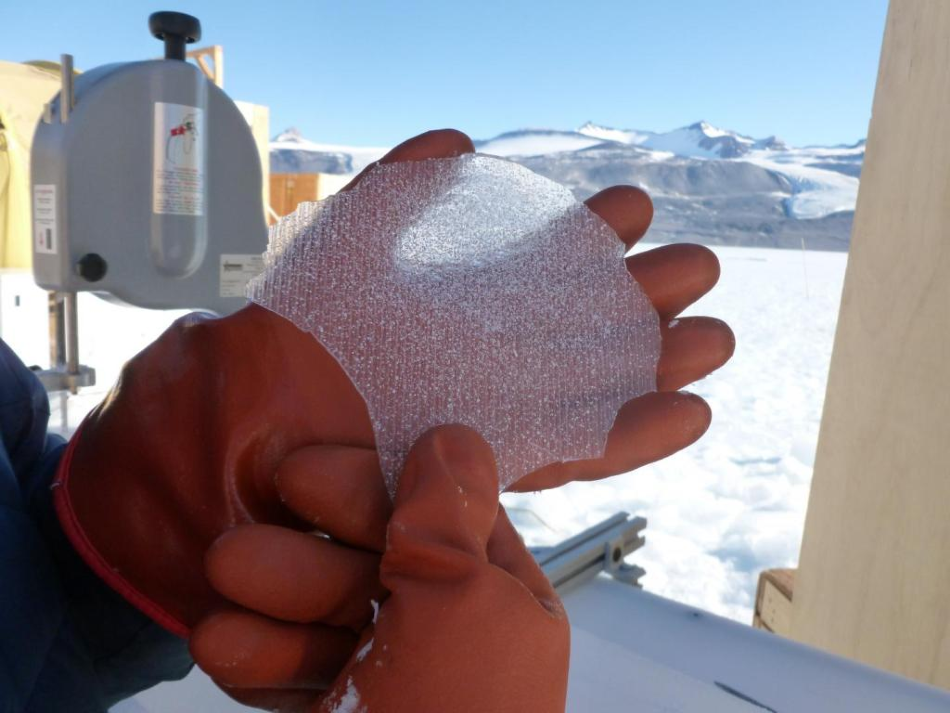Feb 21 2020
Permafrost present in the soil and methane hydrates that occur deep within the ocean serve as huge reservoirs of carbon. As the temperatures of soil and oceans increase, the reservoirs can potentially decompose and discharge large amounts of methane—a powerful greenhouse gas.

Image Credit: University of Rochester photo/Vasilii Petrenko.
However, it is not known whether this methane would really reach the atmosphere.
At the University of Rochester, Michael Dyonisius, a graduate student in the laboratory of Vasilii Petrenko, a professor of earth and environmental sciences, and colleagues analyzed the emissions of methane from a time in Earth’s history somewhat similar to the present warming of Earth.
The researchers’ study indicates that even if these huge natural stores discharge methane in response to warming, only a small amount of this gas would actually make it to the atmosphere. The study was published in the Science journal.
One of our take-home points is that we need to be more concerned about the anthropogenic emissions—those originating from human activities—than the natural feedbacks.
Michael Dyonisius, Graduate Student, Earth and Environmental Sciences, University of Rochester
What are Methane Hydrates and Permafrost?
As soon as plants die, they break down into carbon-based organic matter in the soil. In very cold conditions, the carbon present in the organic matter freezes and, as a result, becomes trapped, without being discharged into the air.
This leads to the formation of permafrost, or soil that is continuously frozen for over a year, even in the summer season. It is largely found on land, specifically in Northern Canada, Alaska, and Siberia.
Together with organic carbon, water ice also occurs abundantly in permafrost. When the rising temperatures thaw the permafrost, the ice begins to melt and inundates the soil within. This helps in producing low-oxygen conditions that provide the ideal setting for the soil microorganisms to ingest the carbon and generate methane.
On the other hand, methane hydrates are predominantly found in ocean sediments together with the continental margins. In the case of methane hydrates, cages of water molecules keep the methane molecules locked within.
Only low temperatures and high pressures lead to the formation of methane hydrates; hence, these compounds occur mostly deep in the ocean. When the temperatures of oceans increase, the temperature of the ocean sediments, where the methane hydrates are present, also increases. Methane hydrates will subsequently destabilize, break down, and discharge the methane gas.
If even a fraction of that destabilizes rapidly and that methane is transferred to the atmosphere, we would have a huge greenhouse impact because methane is such a potent greenhouse gas. The concern really has to do with releasing a truly massive amount of carbon from these stocks into the atmosphere as the climate continues to warm.
Vasilii Petrenko, Professor, Earth and Environmental Sciences, University of Rochester
Gathering Data from Ice Cores
To establish the amount of methane that old carbon deposits are likely to discharge into the air in warming conditions, Dyonisius and his collaborators examined the patterns in Earth’s past. They achieved this by drilling and collecting ice cores from Taylor Glacier located in Antarctica.
The samples of ice core serve like time capsules: they include very small air bubbles with tiny amounts of old air trapped within. The scientists utilized a melting chamber to collect the old air from the tiny bubbles and subsequently analyzed its chemical composition.
Dyonisius’ study focused on qualifying the composition of air from the period of Earth’s last deglaciation that occurred about 8,000 to 15,000 years ago.
The time period is a partial analog to today, when Earth went from a cold state to a warmer state. But during the last deglaciation, the change was natural. Now the change is driven by human activity, and we’re going from a warm state to an even warmer state.
Michael Dyonisius, Graduate Student, Earth and Environmental Sciences, University of Rochester
The researchers examined methane’s carbon-14 isotope in the samples and discovered that emissions of the methane gas from the old carbon reservoirs were actually small. Hence, Dyonisius concluded that “the likelihood of these old carbon reservoirs destabilizing and creating a large positive warming feedback in the present day is also low.”
In addition, Dyonisius and his colleagues concluded that the discharged methane gas does not reach the atmosphere in huge amounts. The team believes that this can be attributed to a number of natural “buffers.”
Buffers Protect Against Release to the Atmosphere
With regard to methane hydrates, if the methane gas is discharged in the deep ocean, a large portion of this gas is dissolved and oxidized by microorganisms present in the ocean before it ever makes it to the air.
If the methane present in permafrost forms sufficiently deep in the soil, it is likely to be oxidized by microbes that consume the methane, or the carbon present in the permafrost may never change into methane and may likely be discharged as carbon dioxide into the air.
“It seems like whatever natural buffers are in place are ensuring there’s not much methane that gets released,” added Petrenko.
Moreover, the data suggests that emissions of methane gas from wetlands increased in reaction to climate change at the time of the last deglaciation, and wetland emissions may probably increase as the world goes on to warm currently.
Nevertheless, “anthropogenic methane emissions currently are larger than wetland emissions by a factor of about two, and our data shows we don’t need to be as concerned about large methane releases from large carbon reservoirs in response to future warming; we should be more concerned about methane released from human activities,” Petrenko added
The U.S. National Science Foundation and the David and Lucille Packard Foundation supported the study.